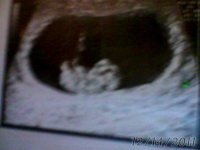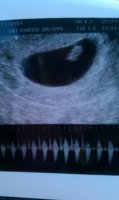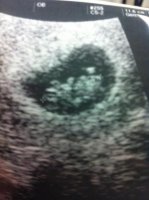daydreaming22
Well-Known Member
- Joined
- Mar 11, 2011
- Messages
- 1,637
- Reaction score
- 0
It supposedly works with early scans. Let me clarify, it is not what side you see bubs on but which side the placenta is attached. Methods are for TV U/S, if you had an abdominal U/S it will be the exact opposite because it is a mirror image. And just as a disclaimer, I am not claiming that this study has any scientific merrit, so please spare the lecture I got last time I posted it  I just think it would be fun to guess with out early scan pics. Come on ladies add your pics and let's play!
I just think it would be fun to guess with out early scan pics. Come on ladies add your pics and let's play!
"This is a multi-center prospective cohort study of 5376 pregnant women that underwent ultrasonography from 1997 to 2007. Trans-vaginal sonograms were performed in 22% of the patients at 6 weeks gestation, and Trans-abdominal sonograms were used at 18-20 weeks gestation, at this time the fetal gender were confirmed in 98-99%. The fetal sex was confirmed 100% after delivery. The study also addressed the bicornuate uteri with single pregnancy in relation to placenta / chorionic villi location. The result was tabulated according to gender and placenta / chorionic villi location. Bicornuate uteri with single fetus in different horns were studied and tabulated
Result
Dramatic differences were detected in chorionic villi / placental location according to gender. 97.2% of the male fetuses had a chorionic villi/placenta location on the right side of the uterus whereas, 2.4% had a chorionic villi/placenta location to the left of the uterus. On the other hand 97.5% of female fetuses had a chorionic villi/placenta location to the left of the uterus whereas, 2.7% had their chorionic villi/placenta location to the right side of the uterus. 127 cases were found to involve bicornuate uteri with single foetuses, most male fetuses were located in the right horn of the uterus and showed right placental laterality (70%). Most female fetuses 59% on the other hand, were located in the left horn and showed left laterality (59%).Moreover, most of the males located in the left horn exhibited right laterality (89%). Also most females located in right horn exhibited left laterality (976.4%). In addition this research indicated that there was a possible link between renal pyelectasis and placental location, and it might be used as a genetic soft marker.
Conclusion
Ramzis method is using placenta /chorionic villi location as a marker for fetal gender detection at 6 weeks gestation was found to be highly reliable. This method correctly predicts the fetus gender in 97.2% of males and 97.5% of females early in the first trimester. And it might be helpful to use as a genetic soft marker in relation with fetal pyelectasis.
In simple terms-
*placenta located on right- 97.2% chance it is a boy
*placenta located on left- 97.5% chance it is a girl
*in a bicornate uterus- 70% males implanted on right with right placental laterality; 59% implanted on left were female with left laterality
*those males that implanted on the left- exhibited right laterality 89% of the time.
*those females that implanted on the right exhibited left laterality of the time.
https://www.obgyn.net/ultrasound/ultr...ental_location
"This is a multi-center prospective cohort study of 5376 pregnant women that underwent ultrasonography from 1997 to 2007. Trans-vaginal sonograms were performed in 22% of the patients at 6 weeks gestation, and Trans-abdominal sonograms were used at 18-20 weeks gestation, at this time the fetal gender were confirmed in 98-99%. The fetal sex was confirmed 100% after delivery. The study also addressed the bicornuate uteri with single pregnancy in relation to placenta / chorionic villi location. The result was tabulated according to gender and placenta / chorionic villi location. Bicornuate uteri with single fetus in different horns were studied and tabulated
Result
Dramatic differences were detected in chorionic villi / placental location according to gender. 97.2% of the male fetuses had a chorionic villi/placenta location on the right side of the uterus whereas, 2.4% had a chorionic villi/placenta location to the left of the uterus. On the other hand 97.5% of female fetuses had a chorionic villi/placenta location to the left of the uterus whereas, 2.7% had their chorionic villi/placenta location to the right side of the uterus. 127 cases were found to involve bicornuate uteri with single foetuses, most male fetuses were located in the right horn of the uterus and showed right placental laterality (70%). Most female fetuses 59% on the other hand, were located in the left horn and showed left laterality (59%).Moreover, most of the males located in the left horn exhibited right laterality (89%). Also most females located in right horn exhibited left laterality (976.4%). In addition this research indicated that there was a possible link between renal pyelectasis and placental location, and it might be used as a genetic soft marker.
Conclusion
Ramzis method is using placenta /chorionic villi location as a marker for fetal gender detection at 6 weeks gestation was found to be highly reliable. This method correctly predicts the fetus gender in 97.2% of males and 97.5% of females early in the first trimester. And it might be helpful to use as a genetic soft marker in relation with fetal pyelectasis.
In simple terms-
*placenta located on right- 97.2% chance it is a boy
*placenta located on left- 97.5% chance it is a girl
*in a bicornate uterus- 70% males implanted on right with right placental laterality; 59% implanted on left were female with left laterality
*those males that implanted on the left- exhibited right laterality 89% of the time.
*those females that implanted on the right exhibited left laterality of the time.
https://www.obgyn.net/ultrasound/ultr...ental_location





